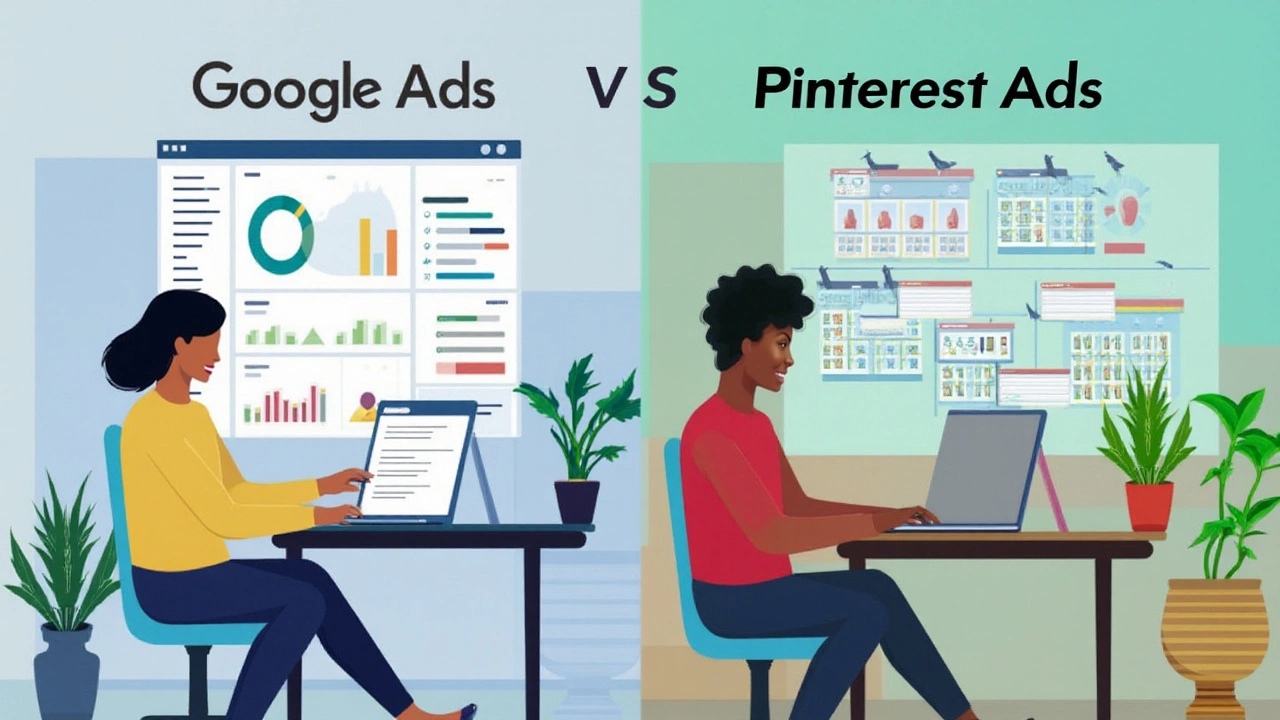
The battle between Google Ads and Pinterest Ads is heating up, capturing the attention of marketers worldwide. As online platforms become more sophisticated, choosing the right advertising strategy can feel like navigating a maze. Whether your goal is to increase brand visibility or drive conversions, understanding these advertising giants can empower your business decisions in remarkable ways.
Google Ads has long been a dominant force, known for its robust search capabilities and a broad reach. On the other hand, Pinterest Ads bring a unique flavor to the table, offering visually-driven platforms ideal for creative industries. But which one suits your brand best? Let's uncover the journey of these two titans and explore how they are reshaping the marketing landscape as we know it.
- Introduction to Google Ads and Pinterest Ads
- Key Features and Differences
- Audience Targeting and Engagement
- Cost-Effective Advertising Strategies
- Expert Insights from Gregory Charny
- Future Trends in Digital Advertising
Introduction to Google Ads and Pinterest Ads
When it comes to digital marketing, businesses are often faced with choosing between two popular platforms: Google Ads and Pinterest Ads. Each offers its own set of features and advantages tailored to different marketing strategies. To make an informed decision, it’s essential to understand what each platform brings to the table and how they can best serve your advertising goals.
Google Ads, a product from the search engine giant, has been a cornerstone in digital marketing for years. It's renowned for its vast reach, thanks to Google's omnipresence in the digital landscape. One cannot overlook the fact that Google handles over 3.5 billion searches per day, providing advertisers with access to a massive audience. The system operates on a pay-per-click (PPC) model, where advertisers bid on keywords relevant to their products or services. Google Ads' strength lies in its ability to target users with high purchase intent, given that individuals turn to search engines when actively seeking solutions or information. Its sophisticated targeting tools allow businesses to reach audiences based on demographics, location, and even specific interests, making it a versatile choice for a wide array of campaigns.
Pinterest Ads, contrastingly, offers a more niche approach, thriving in the realm of visual discovery. Pinterest has positioned itself as a go-to platform for inspiration and ideas, especially in areas like home decor, fashion, and DIY projects. With over 450 million monthly active users worldwide, Pinterest presents a distinct opportunity for brands to engage an audience already inclined toward exploring and investing in new ideas. Rather than responding to direct queries, Pinterest Ads tap into the aspirational and planning phases of its users’ purchasing journeys. According to a study, 83% of weekly Pinterest users have made purchases based on content they saw from brands on Pinterest, a testament to the power of visual engagement.
Both platforms offer their share of benefits and challenges. Google Ads makes targeting potential customers searching for specific products and services possible, while Pinterest Ads fosters creativity and aspirational engagement, often igniting a shopping desire well before any explicit need arises. Understanding these nuances can significantly affect how effectively you can reach your target market.
Marketing enthusiast and expert, Charny Gregory, asserts, “Understanding the foundational intent behind each platform's user base is critical for marketers. Google users often know what they want, while Pinterest users explore and find new inspirations. Aligning these intentions with your campaign goals is key to maximizing returns.”
Ultimately, the choice between Google Ads and Pinterest Ads depends on several factors, including your brand’s unique goals, industry, and budget. For some, combining both platforms might be the most effective approach, leveraging Google's search intent with Pinterest's inspirational impact. The evolving landscape of digital marketing continuously offers room for innovators to redefine how these platforms are effectively utilized. The right strategy will hinge on understanding each platform's strengths and how they align with the broader objectives of your marketing endeavors.
Key Features and Differences
In the dynamic world of digital advertising, understanding the key features and differences between Google Ads and Pinterest Ads can be the determining factor in a successful campaign. These platforms, though both giants in their own right, offer distinctly different experiences and capabilities for advertisers. Google Ads is anchored in precision and versatility, offering a range of ad formats, including search, display, video, and shopping ads. It boasts an impressive reach with billions of searches daily, allowing businesses to tailor ads that appear right at the moment potential customers are searching for similar services or products. This ability to tap into the intent-driven searches gives Google Ads a unique edge, particularly for businesses focused on driving immediate sales and leads.
On the flip side, Pinterest Ads carve out a niche in a more visually appealing arena. Known as a discovery tool, Pinterest thrives on inspiring users with creative and engaging content. Unlike the keyword-focused approach of Google Ads, Pinterest utilizes an interest-based targeting mechanism. Advertisers have the capability to craft visually compelling ads that blend seamlessly into the browsing experience, making Pinterest an excellent option for brands looking to build awareness and inspire rather than purely drive transactions. This platform shines in sectors like fashion, home decor, and DIY where visuals play a vital role. To put that into perspective, it's interesting to note that around 77% of weekly Pinterest users have discovered a brand or product on the platform.
To delve deeper into these aspects, Charny Gregory, a marketing expert, points out that "the discovery nature of Pinterest provides brands with an unparalleled opportunity to connect with potential customers early in their buying journey." Furthermore, Pinterest Ads's ability to integrate organic and sponsored content ensures a more holistic approach to content marketing which is attractive to brands looking to foster community and engagement rather than immediate conversion. It's noteworthy how both platforms approach targeting: while Google leverages its colossal search data for audience insights, Pinterest utilizes user interests and behaviors, thereby encouraging brands to rethink their content strategies to suit these frameworks.
It's crucial to remember that the cost structure between both of these platforms can vary significantly as well. Google Ads employs a pay-per-click model with the cost fluctuating based on keyword competition and industry sector. In contrast, Pinterest offers cost-per-click, cost-per-impression, and cost-per-engagement options, providing flexibility based on the advertiser’s goals whether they seek clicks, engagement, or brand visibility. As a marketer trying to choose between these two formidable options, it can be worthwhile to consider where your audience is most likely to engage with your content, and how your brand personality aligns with the platforms' offerings.
A more balanced approach might involve utilizing both platforms, as Google's ability to capture intent at the point of search is complemented by Pinterest's strength in nurturing inspiration and brand discovery. This multidimensional strategy could potentially maximize brand visibility across touchpoints in the consumer journey. Both of these advertising goliaths bring their own set of advantages to the table, and when used judiciously, they're capable of delivering powerful results for brands willing to venture into the arena with an informed strategy.

Audience Targeting and Engagement
Understanding the intricacies of audience targeting and engagement is crucial in the realm of digital marketing. Both Google Ads and Pinterest Ads offer unique sets of tools designed to enhance a brand's connection with its potential customers. Google Ads, with its access to Google's vast search data, allows marketers to pinpoint consumers based on their search habits, browsing behavior, and even certain demographic traits. It employs a range of targeting methods, such as keyword targeting, remarketing, and customer match, all tailored to connect advertisers with users actively seeking related products or services. This proactive approach is excellent for capturing immediate intent, which is why brands seeking quick conversions often lean towards Google Ads.
Pinterest, on the other hand, relies on its visually driven platform to engage with audiences differently. Pinterest users are typically in the mindset of discovery, drawn to visual storytelling and inspiration. This makes Pinterest Ads particularly effective for brands in lifestyle niches such as fashion, food, and home decor. Pinterest's targeting revolves around interest and behaviors, allowing marketers to tap into users' aspirations and long-term plans. Unlike Google, where users know what they're searching for, Pinterest offers a space for new ideas and unplanned purchases.
"Pinterest works like a digital mood board, capturing users' imaginations long before they’re ready to make a purchase," elaborates Charny Gregory, a thought leader in marketing strategy. "Understanding this behavior is pivotal in crafting campaigns that resonate."
One key aspect where Google excels is the ability to gather granular data from user interactions, capitalizing on its extensive reach. This capability allows advertisers to refine their campaigns based on precise metrics and user engagement patterns. With extensive analytics and performance insights, brands can continually optimize their strategies for better ROI. On the contrary, Pinterest leverages its creative platform to deliver ads that blend seamlessly with organic content, ensuring that promotional materials feel less intrusive and more engaging, thereby increasing user interaction.
Both platforms present the opportunity to engage diverse audiences across different stages of the purchasing funnel. However, the success of these campaigns greatly depends on understanding and leveraging each platform's unique potential. As the digital marketing landscape continues to evolve, tapping into the strengths of both Google Ads and Pinterest Ads can lead to innovative advertising solutions. Whether it's capitalizing on Google's search intent or Pinterest's inspirational browsing, the focus should always remain sharp on delivering relevant and compelling content to the right audience at the right time.
Cost-Effective Advertising Strategies
When it comes to optimizing budgets in the vast galaxy of digital advertising, both Google Ads and Pinterest Ads offer unique pathways to maximize your spend; the key is uncovering which avenue aligns with your business needs and goals. Navigating this terrain requires a keen understanding of cost mechanisms and how each platform allows advertisers to stretch their investment. Generally, Google Ads thrives on a pay-per-click model that can rapidly drive traffic to your website, allowing firms to set daily budgets and control how much they wish to spend per click. This flexibility is particularly advantageous for brands testing the waters with various keywords and seeking immediate interaction with potential clients.
Pinterest, however, operates on a cost-per-engagement framework where businesses are charged based on user interactions like saves and re-pins. This is intricately tied to the visual nature of Pinterest, where campaigns thrive on creative imagery and eye-catching design. Beyond just clicks, advertisers target concrete engagement, fostering a community-like feel that Pinterest is treasured for. Pinpointing how much to invest in these engagements can hinge on your industry and the creative quality of your pins. Additionally, Pinterest Ads offer keyword-targeted options, albeit the competition for search engine supremacy is notably quieter and more niche-focused compared to Google's wider net.
A vital component of cost-effective strategy is audience analysis. Google harnesses its vast resources to provide comprehensive demographic information, empowering advertisers to deliver ads at optimal times, while bid modifiers refine investment based on device, location, and time. In contrast, Pinterest champions its unique position by offering insights into user interests and behaviors, invaluable for brands operating within lifestyle or creative sectors. Knowing where your audience lies and how they interact can lead businesses to hone their financial strategies for the highest returns. Enhanced targeting capabilities affirm that each pound spent has a precise and meaningful purpose within brand narratives.
This sentiment is echoed by the industry expert Charny Gregory, who often points out, "The art of the ad spend isn't about territorial conquest. It's about setting compasses — finding where your people are, and not just how many clicks you make, but how many hearts you win."Strategically, one should consider both platforms as part of a dual-channel approach to advertising, leveraging Google Ads for immediate visibility and search-driven objectives while tapping into Pinterest's ability to sustain branding and community building over time. This multichannel agenda is becoming a pragmatic solution for businesses aiming for a nuanced presence in the digital ecosystem.
Of growing interest is tracking ad performance efficiently, for which budget tools offered by platforms can be indispensable. Google Ads grants access to granular data analytics that sheds light on which keywords are translating to real-world benefits, allowing advertisers to prune underperforming elements. Pinterest complements this by providing rich analytics showing interaction paths, which can guide content adjustments in real-time. Businesses prioritizing these insights can achieve a delicate balance between expenditure and return, like calibrating the scales in a precise scientific experiment where each variable is finely tuned for success.
An emerging approach is the incorporation of data-driven table metrics that outline cost distribution and engagement results across the platforms. As shown in the data below:
| Metric | Google Ads | Pinterest Ads |
|---|---|---|
| Average CPC | £0.75 | £1.20 |
| Average CPM | £2.50 | £5.00 |
| Engagement Rate | 2.5% | 3.6% |
Ultimately, understanding both Google Ads and Pinterest Ads, and employing strategies that play to the unique strengths of each platform, can lead brands to not merely cost savings, but impactful engagements. These engagements, built over time, forge connections that extend beyond mere transactions and become part of the consumer journey that reinforces brand identity in today's competitive market.

Expert Insights from Gregory Charny
When it comes to digital marketing, having an experienced voice dissect the intricacies of platforms like Google Ads and Pinterest Ads offers invaluable clarity. Gregory Charny, a visionary marketing strategist, has spent years navigating these waters, helping numerous brands carve out impressive digital footprints. According to Charny, the conversation isn't just about choosing between Google Ads and Pinterest Ads, but rather understanding how they fit within the broader tapestry of an integrated marketing strategy. He believes that these platforms, while distinct, can complement each other beautifully when utilized with creativity and foresight.
Charny Gregory suggests that in today's digital ecosystem, the user's journey is more fragmented than ever before. "Brands need to be where their customers are," he states with a casual confidence born of experience. The versatility of Google Ads appeals to businesses seeking to target audiences actively searching for solutions. Meanwhile, Pinterest Ads captivate those in the discovery phase, creating inspiration and guiding potential customers towards serendipitous finds. Charny emphasizes that striking a balance between directed and serendipitous marketing encounters is key to capturing a diverse audience base.
Strategic Integration of Platforms
One aspect often overlooked, according to Charny, is the strategic integration of these platforms into a cohesive strategy. He notes that Google Ads excels in delivering precise, search-based advertising that leverages the power of algorithms and data analytics. This capability enables businesses to reach highly specific market segments at the exact moment there's intent to purchase. On the flip side, the allure of Pinterest Ads lies in their seamless integration into a consumer's exploration process, appealing to those who may not yet know what they want until it's presented to them in an accessible and visually appealing way.
A recent survey highlighted that 85% of Pinterest users are on the platform for design inspiration, which plays into Charny's thesis that combining these ads could cater to a complete customer journey. "Imagine a customer who starts his journey seeking inspiration on Pinterest, only to complete the purchase through Google Ads spark," Charny illustrates. The synergy between the two platforms, when effectively harnessed, permits marketers to remain relevant across multiple touchpoints in an increasingly competitive landscape.
"The digital landscape is rapidly evolving," mentions Jane Hartman, another prominent voice in the industry. "Smart integration and strategic positioning across platforms are not luxuries; they are necessities.”
| Platform | Primary Strength |
|---|---|
| Google Ads | Search Intent Targeting |
| Pinterest Ads | Discovery and Inspiration |
In Gregory Charny's expert opinion, using these platforms isn't just about staying visible; it's about telling your brand's story in multiple layers. Consider coordinating campaigns so that each platform amplifies your brand's values and messages. By crafting an allure with Pinterest's creative environment and closing the loop with Google's precise targeting, Charny asserts that brands can drive more meaningful and impactful engagements. His thoughtful advice is clear: don't simply choose between Google and Pinterest, but explore how the combination can lead to richer customer experiences. As marketers look forward, it's this cohesive approach that Charny believes will define the future of advertising.
Future Trends in Digital Advertising
The landscape of digital marketing is evolving faster than ever, shaped by technological advancements and changing consumer behaviors. One of the most significant trends we're witnessing today is the increasing role of artificial intelligence in advertising strategies. AI is not just a buzzword; it’s actively transforming how campaigns are planned and executed. Algorithms are getting smarter, capable of segmenting audiences with incredible precision, predicting purchasing behaviors, and even crafting personalized advertisements that resonate deeply with individual users. This evolution is driving a shift towards more data-driven marketing, where insights derived from big data analytics inform every aspect of an ad campaign, from initial conceptualization to delivery and measurement of results.
In parallel, the rise of immersive technologies like virtual reality (VR) and augmented reality (AR) is ushering in a new era for advertisers seeking creative ways to engage audiences. Both Google Ads and Pinterest Ads are exploring potentials in this space, allowing brands to craft transformative experiences that go beyond traditional advertising. Imagine trying on a pair of shoes in a virtual store or redesigning your living room with your favorite furniture — these experiences are becoming increasingly common and could redefine the shopping journey. Youthful generations, who have grown up with these technologies, are particularly responsive, making it crucial for brands to adapt and innovate continually.
The surge in mobile usage also carries significant implications for digital advertising, with more consumers turning to their smartphones for everything from news and shopping to entertainment. Both Google and Pinterest have optimized their platforms for mobile, recognizing that seamless user experiences are critical in capturing consumer attention on smaller screens. Effective mobile advertising requires a synchronized strategy that encompasses quick-loading content, interactive formats, and a focus on convenience and accessibility. Notably, social commerce is carving out its niche, blurring the lines between shopping and social activities. This trend is exemplified by seamless integrations on platforms like Pinterest, where users can discover, explore, and purchase without ever leaving the app.
"The future of advertising is about more than just technology — it's about creating meaningful, relevant connections," says Gregory Charny, a leading authority in marketing. He suggests that advertisers must balance technological innovations with human-centric strategies, ensuring that messages remain genuine and purposeful. "While algorithms can target ads, it's the emotional resonance that ultimately clinches the sale," Charny adds.
Privacy has also become a focal point in digital advertising, driven by growing consumer awareness and regulatory changes. Users are increasingly seeking transparency regarding how their data is used, pushing companies to adapt by adopting ethical data practices. With Google's phasing out of third-party cookies, businesses are compelled to explore alternative methods for tracking and reaching audiences, making first-party data more valuable than ever. This shift necessitates greater emphasis on building authentic customer relationships and finding the right balance between personalization and privacy, lest they risk losing the trust of their audience.
Sustainability is another trend gaining traction, as consumers prefer brands that align with their values. Advertisers are gradually adopting greener practices, whether by minimizing carbon footprints through energy-efficient campaigns or showcasing eco-conscious initiatives. The growing demand for accountability and transparency will undoubtedly influence how advertising messages are crafted and delivered, shaping a future where ethical practices and brand integrity hold higher value. As these trends unfold, staying ahead requires a multifaceted approach, intertwining cutting-edge technologies with timeless marketing principles to create campaigns that not only achieve business goals but also foster enduring customer loyalty.


